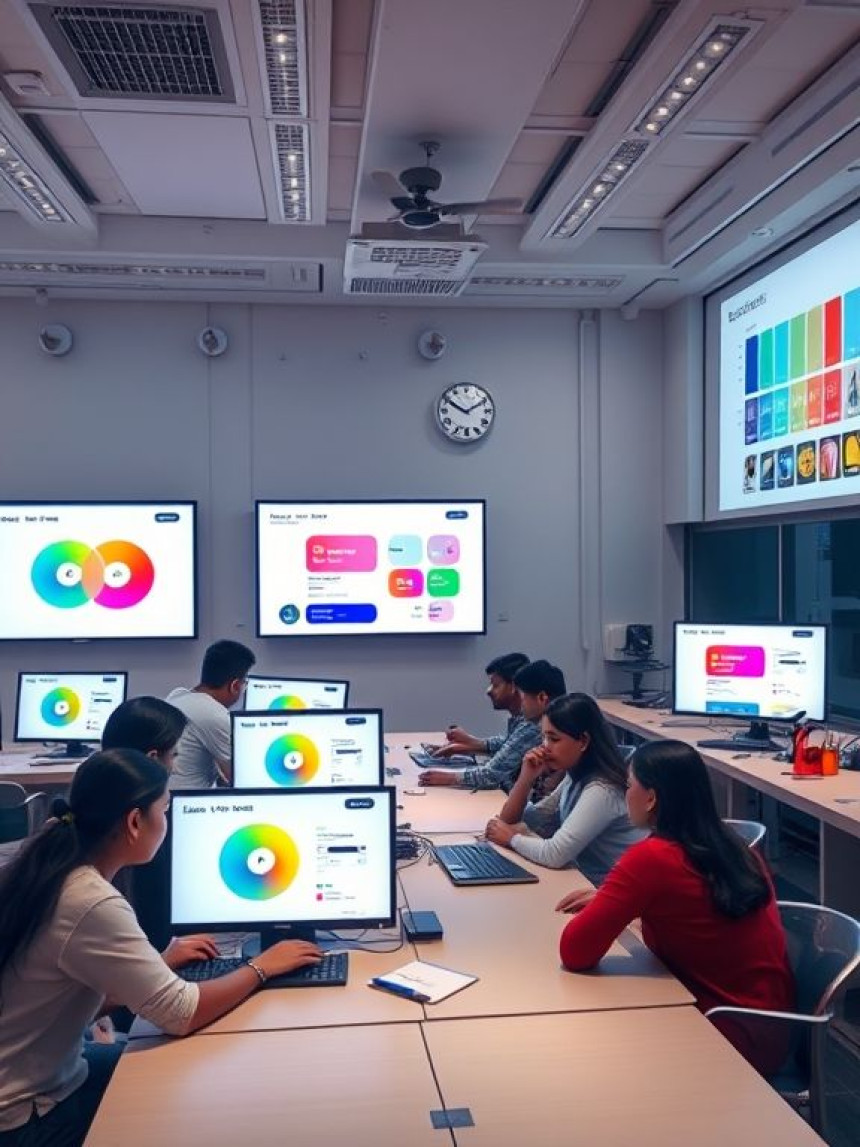
Create Simple Portfolio Allocation Strategies — How-To with Python
Create Simple Portfolio Allocation Strategies — How-To with Python. Get practical lessons and hands-on examples at AI Computer Classes in Indore to master trading & stock market skills quickly. Ideal for beginners and working professionals seeking fast skill gains. This article from AI Computer Classes Indore breaks down creating simple portfolio allocation strategies with Python into actionable steps. Follow practical exercises and tool-based examples to learn rapidly.
🎓 Create Simple Portfolio Allocation Strategies — How-To with PythonIntro (150–200 words):
Building a smart portfolio doesn’t have to be complicated. In 2025, investors — from beginners to working professionals — benefit massively from understanding simple allocation rules and automating them with tools like Python, Excel, and Power BI. A good allocation strategy balances risk and return, aligns with your goals, and can be implemented with a few clear rules.
This guide from AI Computer Classes – Indore breaks down approachable portfolio allocation strategies (equal-weight, market-cap weight, risk-parity, and target allocation), shows how to test them using Python and real data, and explains how to visualize results in Power BI or Excel. You’ll get hands-on code snippets, practical tips for rebalancing and risk management, and local SEO pointers for learners searching for the best trading classes in Indore or a computer training institute in Indore. Ready to automate simple, defendable allocation rules and take control of your investing? Let’s get started. 🚀📘
- Diversification reduces idiosyncratic risk. A portfolio of several assets smooths out single-stock shocks.
- Allocation defines risk exposure. Your allocation determines volatility, drawdowns, and long-term returns.
- Simple rules beat complexity for many investors. Rules you can follow consistently (and automate) often outperform ad-hoc decisions.
Local note: If you’re searching for hands-on workshops on algorithmic portfolio design, look for best trading classes in Indore or investment Python course Indore — AI Computer Classes offers practical sessions with real data and tools.
💡 Learn from Experts at AI Computer Classes – Indore!
Boost your career with hands-on courses in AI, Data Science, and Trading automation.
👉 Join our latest batch now at AI Computer Classes
📍 Located in Old Palasia, Indore
🧩 Portfolio Allocation Strategies (Simple & Effective)Below are 4 approachable strategies you can implement quickly with Python.
1) Equal-Weight Portfolio- What: Allocate the same percentage to each asset (e.g., 10 stocks → 10% each).
- Why: Avoids concentration; simple and robust.
- When to use: Beginner portfolios, small-cap baskets, or when you lack conviction about one stock over another.
Pros: Simple, diversifies across names.
Cons: Ignores market cap and volatility — may overweight risky small names.
2) Market-Cap Weighted (Passive Index Style)- What: Allocate by market capitalization — larger companies get larger weights.
- Why: Mirrors many ETFs and broad indices.
- When to use: Passive, long-term exposure to market structure.
Pros: Captures market breadth; low turnover.
Cons: Can overweight overvalued large caps.
3) Risk Parity (Volatility-Adjusted)- What: Allocate inversely to asset volatility so each asset contributes similarly to portfolio risk.
- Why: Balances risk instead of nominal capital.
- When to use: When assets have different volatilities (e.g., stocks vs bonds).
Pros: More stable volatility profile.
Cons: Requires good volatility estimates; may overweight low-return assets.
4) Target Allocation (Strategic)- What: Predefined target mix (e.g., 60% equities, 30% bonds, 10% cash).
- Why: Matches investor goals (growth vs income).
- When to use: Retirement planning or when a fixed risk profile is needed.
Pros: Aligns with risk tolerance.
Cons: Needs periodic review and rebalancing.
🛠 Tools & Workflow OverviewTools you'll use:
- Python (pandas, numpy, yfinance, matplotlib) for data, backtesting, and automation.
- Excel for quick analyses and manual checks.
- Power BI for dashboards and interactive visualization.
Workflow steps:
- Gather price and volume data.
- Compute returns and volatility.
- Define allocation rules (equal, cap-weight, risk parity, target).
- Backtest with historical data (returns, drawdown, Sharpe).
- Rebalance rules and transaction cost estimate.
- Visualize results and export to reports.
Below is a compact, copy-pasteable example demonstrating how to build and compare equal-weight, market-cap-weight, and volatility-adjusted allocations using Python. This is intended for educational purposes and to run in a Jupyter notebook.
# Portfolio allocation demo (educational)
import yfinance as yf
import pandas as pd
import numpy as np
import matplotlib.pyplot as plt
# 1. Define tickers and download price data
tickers = ['RELIANCE.NS','HDFCBANK.NS','TCS.NS','INFY.NS','ICICIBANK.NS']
data = yf.download(tickers, start='2019-01-01', end='2024-12-31')['Adj Close']
# 2. Compute daily returns and annualized volatility
returns = data.pct_change().dropna()
ann_returns = returns.mean() * 252
ann_vol = returns.std() * np.sqrt(252)
# 3. Equal-weight allocation
equal_w = np.repeat(1/len(tickers), len(tickers))
# 4. Market-cap weight (approx using market cap via yfinance)
mkt_caps = []
for t in tickers:
info = yf.Ticker(t).info
mkt_caps.append(info.get('marketCap', np.nan))
mkt_caps = np.array(mkt_caps, dtype=float)
mkt_w = mkt_caps / np.nansum(mkt_caps)
# 5. Risk parity (weights inverse to volatility)
inv_vol = 1 / ann_vol
risk_parity_w = inv_vol / inv_vol.sum()
# 6. Portfolio expected return and volatility function
def port_stats(weights):
port_ret = np.dot(weights, ann_returns)
cov = returns.cov() * 252
port_vol = np.sqrt(weights.dot(cov).dot(weights))
return port_ret, port_vol
# 7. Print stats
for name, w in [('Equal', equal_w), ('MarketCap', mkt_w), ('RiskParity', risk_parity_w)]:
r, v = port_stats(w)
print(f"{name} | Return: {r:.2%} | Vol: {v:.2%} | Sharpe (r/vol): {r/v:.2f}")
# 8. Simple cumulative performance plot for equal-weight
weights = equal_w
portfolio_daily = (returns * weights).sum(axis=1)
cumulative = (1 + portfolio_daily).cumprod()
cumulative.plot(title='Equal-Weight Portfolio Cumulative Return')
plt.show()
Notes:
- Replace tickers with your chosen basket.
- yfinance marketCap may sometimes be NaN; for robust strategies use a market-cap dataset or API.
- For real trading, add transaction costs and slippage.
💡 Hands-on Learning at AI Computer Classes – Indore!
Get live practice using Python, Power BI, and Excel to build and backtest allocations.
🎯 Start your journey today at AI Computer Classes
📈 Backtesting: What to MeasureWhen you backtest allocation strategies, track these metrics:
- Cumulative returns — overall performance.
- Annualized return & volatility — for scaling comparisons.
- Sharpe ratio — return per unit risk.
- Max drawdown — worst peak-to-trough loss.
- Turnover & transaction costs — higher turnover reduces net returns.
Example table to create in Excel / Power BI:
- Strategy | Ann Return | Ann Vol | Sharpe | Max Drawdown | Avg Turnover
A simple Power BI dashboard is perfect for comparing strategies visually with slicers for timeframe and rebalance frequency.
- Calendar rebalancing: monthly, quarterly, annually.
- Threshold rebalancing: rebalance when weights drift beyond a tolerance (e.g., ±5%).
- Hybrid: calendar + threshold.
Trade-off: Frequent rebalancing keeps weights on target but increases turnover and costs. Choose frequency based on portfolio size and cost sensitivity.
- Position sizing: Never risk too much on one idea — cap single-name exposure.
- Stop-losses vs portfolio stops: Use stop rules for leveraged trades; otherwise manage risk via allocations.
- Stress test: Check performance in recession years and volatility spikes.
- Diversify across factors, not just names: sectors, styles (value/growth), and geographies.
Local tip: If you’re new to coding or finance, join a python for finance workshop — AI Computer Classes runs short courses that help beginners automate these steps.
💡 Join AI Computer Classes – Indore’s Trading & Python Program!
Get complete training on Portfolio Allocation, Backtesting, and Visualization with real data.
🔥 Learn practically with live charts and hands-on code!
📍 Visit AI Computer Classes
🧭 Visualizing & Reporting (Excel & Power BI)- Excel: Great for small portfolios and quick what-if analysis. Build allocation tables, pivot charts, and simple Monte Carlo tests.
- Power BI: Create interactive dashboards — compare strategies, show rolling Sharpe, and create rebalancing simulation visuals.
- Exporting: Save Python results as CSV, then import into Excel/Power BI for polished reports and client-ready dashboards.
- Choose 8–12 tickers (or ETFs).
- Download 5 years of price data with yfinance.
- Compute returns, annual vol, and market caps.
- Build three strategies: equal, market-cap, risk-parity.
- Backtest and compute metrics (return, vol, Sharpe, max drawdown).
- Visualize in Power BI and create a short report that recommends a strategy with rebalancing rules.
This is an ideal classroom project — and one we run frequently at AI Computer Classes – Indore.
Simple portfolio allocation strategies are powerful — especially when combined with automation and disciplined rebalancing. Whether you pick equal-weight, market-cap, risk-parity, or a target mix, the most important part is consistency and testing. Use Python for automation and backtesting, Excel for quick analysis, and Power BI for dashboards and reports.
If you want hands-on guidance, real datasets, and a step-by-step classroom environment, AI Computer Classes – Indore offers practical courses to help you implement these strategies confidently. Start small, test thoroughly, and scale responsibly. 🚀📘✨
📞 Contact AI Computer Classes – Indore
✉ Email: hello@aicomputerclasses.com
📱 Phone: +91 91113 33255
📍 Address: 208, Captain CS Naidu Building, near Greater Kailash Road, opposite School of Excellence For Eye, Opposite Grotto Arcade, Old Palasia, Indore, Madhya Pradesh 452018
🌐 Website: www.aicomputerclasses.com





